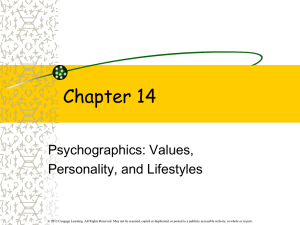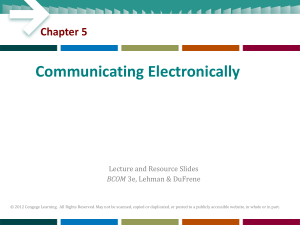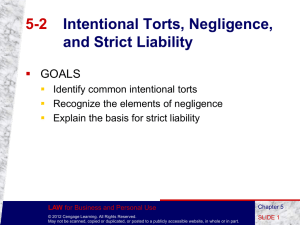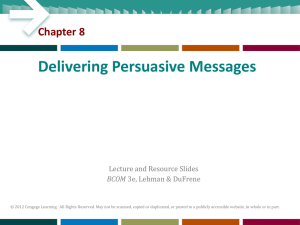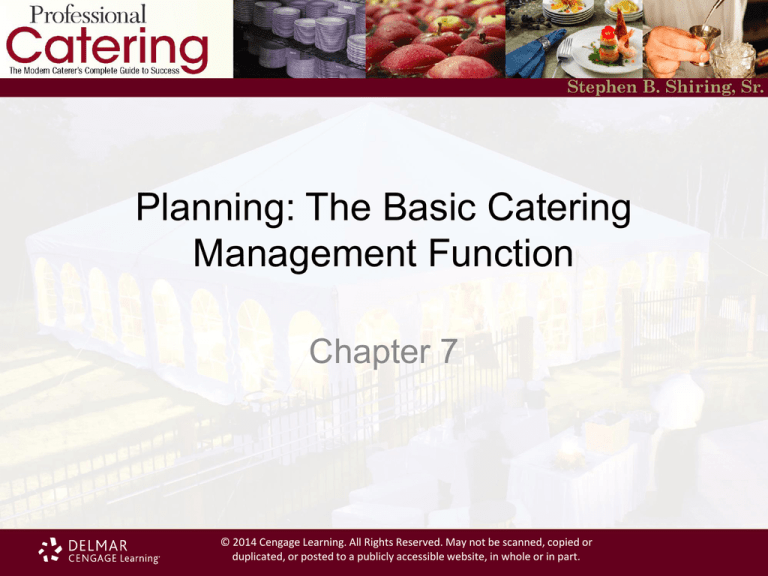
Planning: The Basic Catering
Management Function
Chapter 7
© 2014 Cengage Learning. All Rights Reserved. May not be scanned, copied or
duplicated, or posted to a publicly accessible website, in whole or in part.
Planning: The Basic Catering Management
Function
• A successful caterer is well-focused and organized
through planning.
• Each event must have an independent subplan
based on client needs and the caterer’s plan.
• The best caterers always think about upcoming
events.
• Details are critically important.
© 2014 Cengage Learning. All Rights Reserved. May not be scanned, copied or
duplicated, or posted to a publicly accessible website, in whole or in part.
Strategies Emerge Through Planning
•
•
•
•
•
Blueprint
Guidance
Objectives
Strategies
“What if” scenarios
© 2014 Cengage Learning. All Rights Reserved. May not be scanned, copied or
duplicated, or posted to a publicly accessible website, in whole or in part.
Getting Ready to Plan
• Objectives are based on:
– Interpreted customer needs and wants
– Caterer’s financial and professional needs
• The plan must reflect:
– When it will be done
– How it will be done
– How much it will cost
– The potential profit
• Always include a review of the mission statement.
© 2014 Cengage Learning. All Rights Reserved. May not be scanned, copied or
duplicated, or posted to a publicly accessible website, in whole or in part.
Formulating a Catering Plan
• Required Elements
– Budget
– Menu
– Location
– Number of Guests
– Labor requirements
• Required Objectives
– Financial
– Customer satisfaction
© 2014 Cengage Learning. All Rights Reserved. May not be scanned, copied or
duplicated, or posted to a publicly accessible website, in whole or in part.
The Menu: A Tactical Plan
• The menus is the single most important factor
contained in the overall plan.
– Menu format
– Standardized menu
– Complexity of the plan
• Attention given to:
– Satisfying client needs
– Staff skills
– Seasonal availability of food
© 2014 Cengage Learning. All Rights Reserved. May not be scanned, copied or
duplicated, or posted to a publicly accessible website, in whole or in part.
Barriers to Planning
• Operational barriers
– Disrupt the physical elements of an event
– Deal with time
• Human resource or communication barriers
– Human error
– Lack of communication
© 2014 Cengage Learning. All Rights Reserved. May not be scanned, copied or
duplicated, or posted to a publicly accessible website, in whole or in part.
Purposes of a Business Plan
•
•
•
•
Sets the direction for the organization
Communicates intended growth of company
Discloses organization’s financial goals
Presents overall business vision
© 2014 Cengage Learning. All Rights Reserved. May not be scanned, copied or
duplicated, or posted to a publicly accessible website, in whole or in part.
Outline of a Successful Business Plan
•
•
•
•
•
•
•
•
•
•
•
Front
Body
Description
Industry analysis
Target market
Marketing
Competition
Operations
Management and organization
Financial data and projections
Long-term development and exit-plan
© 2014 Cengage Learning. All Rights Reserved. May not be scanned, copied or
duplicated, or posted to a publicly accessible website, in whole or in part.
Hazardous Analysis and Critical Control Point
Plan
• HACCP is a prevention-based food safety plan.
• Monitoring and verification steps included.
1. Hazard analysis
2. Identify critical control points in food production.
3. Establish critical limits for preventative measures.
4. Establish procedures to monitor CCPs.
5. Establish corrective actions.
6. Establish procedures to verify HACCP system
works.
7. Establish effective record keeping systems.
© 2014 Cengage Learning. All Rights Reserved. May not be scanned, copied or
duplicated, or posted to a publicly accessible website, in whole or in part.








